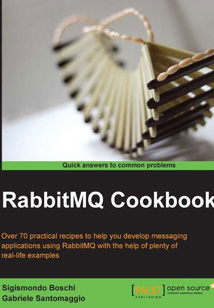舉報 

會員
RabbitMQ Cookbook
最新章節:
Index
Apracticalbookfilledwithadvancedrecipesaswellasplentyofcodeandreal-lifeexampleswhichwillmakeyourlearningcurvequickandeasy.Ifyouareasoftwaredeveloperwhowantstodevelopdistributedapplicationsbasedonmessaging,thenthisbookisforyou.It’sassumedthatyouhavesomeexperiencewithmultithreadingapplicationsanddistributedapplications.YouarealsoexpectedtoknowthebasicconceptsofWebandcloudapplicationsinordertofollowtherecipeseffectively.
目錄(115章)
倒序
- coverpage
- RabbitMQ Cookbook
- Credits
- About the Authors
- About the Reviewers
- www.PacktPub.com
- Support files eBooks discount offers and more
- Preface
- What this book covers
- What you need for this book
- Who this book is for
- Conventions
- Reader feedback
- Customer support
- Chapter 1. Working with AMQP
- Introduction
- Connecting to the broker
- Producing messages
- Consuming messages
- Using body serialization with JSON
- Using RPC with messaging
- Broadcasting messages
- Working with message routing using direct exchanges
- Working with message routing using topic exchanges
- Guaranteeing message processing
- Distributing messages to many consumers
- Using message properties
- Messaging with transactions
- Handling unroutable messages
- Chapter 2. Going beyond the AMQP Standard
- Introduction
- How to let messages expire
- How to let messages expire on specific queues
- How to let queues expire
- Managing rejected or expired messages
- Understanding the alternate exchange extension
- Understanding the validated user-ID extension
- Notifying the consumers of queue failures
- Understanding the exchange-to-exchange extension
- Embedding message destinations within messages
- Chapter 3. Managing RabbitMQ
- Introduction
- Using vhosts
- Configuring users
- Using SSL
- Implementing client-side certificates
- Managing RabbitMQ from a browser
- Configuring RabbitMQ parameters
- Developing Python applications to monitor RabbitMQ
- Developing your own web applications to monitor RabbitMQ
- Chapter 4. Mixing Different Technologies
- Introduction
- Using a .NET client
- Binding an app from iPhone to RabbitMQ via MQTT
- Using messaging to update Google Maps on Android
- Publishing messages from Android in the background
- Exchanging RabbitMQ messages with Qpid
- Exchanging RabbitMQ messages with Mosquitto
- Binding a WCF application with .Net clients
- Chapter 5. Using RabbitMQ in Web Applications
- Introduction
- Developing web monitoring applications with Spring
- Developing asynchronous web searches with Spring
- Developing web monitoring applications with STOMP
- Chapter 6. Developing Scalable Applications
- Introduction
- Creating a localhost cluster
- Creating a simple cluster
- Adding a RabbitMQ cluster automatically
- Introducing a load balancer to consumers
- Creating clients of the cluster
- Chapter 7. Developing High-availability Applications
- Introduction
- Mirroring queues
- Synchronizing queues
- Optimizing mirror policies
- Distributing messages between a couple of brokers
- Creating a geographical cluster replication
- Filtering and forwarding messages
- Combining high-availability technologies together
- Client high availability
- Chapter 8. Performance Tuning for RabbitMQ
- Introduction
- Multithreading and queues
- System tuning
- Improving bandwidth
- Using different distribution tools
- Chapter 9. Extending RabbitMQ Functionality
- Introduction
- Enabling and configuring the STOMP plugin
- Managing a RabbitMQ cluster
- Monitoring Shovel status
- Developing new plugins – attaching to a relational database with ODBC
- Chapter 10. RabbitMQ on AWS
- Introduction
- Using RabbitMQ EC2 instances
- Creating a master image
- Creating a cluster with two EC2 instances
- Using AWS Load Balancing in front of a RabbitMQ cluster
- Configuring EC2 dynamic bind
- Dealing with load spikes and resource optimization in the cloud
- Chapter 11. AMQP and Cloud Computing – RabbitMQ on PaaS
- Introduction
- RabbitMQ on CloudAMQP
- First application on Cloud Foundry
- Using RabbitMQ on Cloud Foundry
- Chapter 12. Managing RabbitMQ Error Conditions
- Introduction
- Monitoring RabbitMQ's behavior
- Using RabbitMQ to troubleshoot itself
- Tracing RabbitMQ's ongoing activity
- Debugging RabbitMQ's messages
- What to do when RabbitMQ fails to restart
- Debugging using Wireshark
- Index 更新時間:2021-07-19 18:53:10
推薦閱讀
- Building Cross-Platform Desktop Applications with Electron
- Python應用輕松入門
- C語言從入門到精通(第4版)
- The Data Visualization Workshop
- TypeScript項目開發實戰
- 大模型RAG實戰:RAG原理、應用與系統構建
- 微服務架構深度解析:原理、實踐與進階
- Mastering Web Application Development with AngularJS
- Geospatial Development By Example with Python
- Go語言編程
- Angular Design Patterns
- Python應用開發技術
- Using Yocto Project with BeagleBone Black
- MySQL數據庫教程(視頻指導版)
- Processing開發實戰
- SQL Server 2014數據庫設計與開發教程(微課版)
- Puppet Essentials
- Android性能優化之道:從底層原理到一線實踐
- Visual C++.NET 2010開發實踐:基于C++/CLI
- 面向對象技術與工具(第2版)
- Getting Started with Beautiful Soup
- ReactJS by Example:Building Modern Web Applications with React
- Learning System Center App Controller
- C++ 黑客編程揭秘與防范
- 麥克奇遇記:Scratch 2.0探險之旅(創客教育)
- C#網絡應用編程(第3版)
- Cocos2d-x學習筆記:完全掌握JS API與游戲項目開發 (未來書庫,觸控未來官方教材)
- Highcharts Essentials
- PowerCLI Essentials
- Java從入門到精通(第4版)

